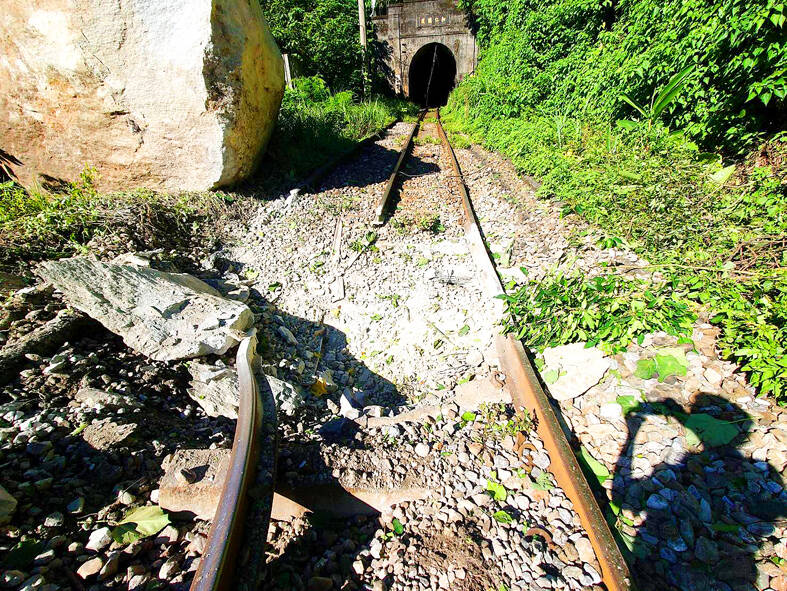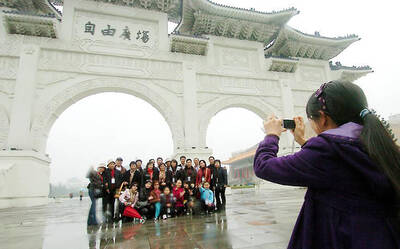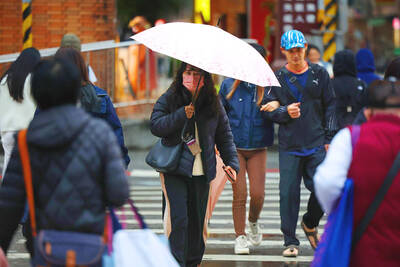New ways of thinking should be applied to the management of roads and highways in Hualien County, as its mountain slopes could remain unstable for the next seven to eight years, an official from the Directorate-General of Highways said after a rockfall damaged railway tracks near Heren Tunnel in the county’s Sioulin Township (秀林) yesterday.
Rockfalls and landslides have affected Suhua Highway and the North-link rail line more often than normal since a large earthquake in Hualien County on April 3.
The earthquake, which measured 7.2 on the Richter scale, struck 15km south of Hualien City and was the strongest temblor in Taiwan since 1999.

Photo courtesy of Taiwan Railway Corp
A rock weighing an estimated 150 tonnes yesterday destroyed tracks near the tunnel. Heavy rain caused a landslide on Monday that buried part of the Suhua Highway between Heren (和仁) and Chongde (崇德).
The east railway line between the two communities has been temporarily closed, with trains running in both directions on the west line, Taiwan Railway Corp said.
There were multiple rockfalls and landslides last month, including a slide that led to the derailment of a New Tze-chiang Limited Express near the Cingshuei River (清水溪) on June 21.
April’s earthquake affected areas up to an altitude of 1,000m and resulted in unprecedented damage to the Suhua Highway and the Central Cross-lsland Highway, with much of the region’s vegetation ruined by slope collapses and falling rocks, Directorate-General of Highways official Lin Wen-hsiung (林文雄) said.
“Due to the damage, 10mm of rainfall could cause a rockfall, when it used to take 50mm to 60mm,” Lin said.
For example, only 1mm of rainfall led to the June 21 derailment, he said, adding that rockfalls are occurring almost every day on slopes along the Central Cross-lsland Highway, which passes through Taroko Gorge.
The slopes and roads in mountainous areas would “remain unstable for the following seven to eight years, or even 20 years” based on Japan’s experience after the Great Hanshin-Awaji Earthquake on Jan. 17, 1995, so “we should abandon outdated ideas and consider newly developed situations to manage roads and highways,” Lin said.
People will have to be prepared for land collapses for years to come, although senior officials say the rockfall situation might stabilize after typhoons clear unstable material, he said.
In addition to slope maintenance, rockfall barriers and fences should be added and more rock sheds, or open-cut tunnels, should be built on the roads that pass through Taroko Gorge, Lin said, adding that most of the engineering projects have already been outsourced to contractors.

US climber Alex Honnold is to attempt to scale Taipei 101 without a rope and harness in a live Netflix special on Jan. 24, the streaming platform announced on Wednesday. Accounting for the time difference, the two-hour broadcast of Honnold’s climb, called Skyscraper Live, is to air on Jan. 23 in the US, Netflix said in a statement. Honnold, 40, was the first person ever to free solo climb the 900m El Capitan rock formation in Yosemite National Park — a feat that was recorded and later made into the 2018 documentary film Free Solo. Netflix previewed Skyscraper Live in October, after videos

Starting on Jan. 1, YouBike riders must have insurance to use the service, and a six-month trial of NT$5 coupons under certain conditions would be implemented to balance bike shortages, a joint statement from transportation departments across Taipei, New Taipei City and Taoyuan announced yesterday. The rental bike system operator said that coupons would be offered to riders to rent bikes from full stations, for riders who take out an electric-assisted bike from a full station, and for riders who return a bike to an empty station. All riders with YouBike accounts are automatically eligible for the program, and each membership account

NUMBERS IMBALANCE: More than 4 million Taiwanese have visited China this year, while only about half a million Chinese have visited here Beijing has yet to respond to Taiwan’s requests for negotiation over matters related to the recovery of cross-strait tourism, the Tourism Administration said yesterday. Taiwan’s tourism authority issued the statement after Chinese-language daily the China Times reported yesterday that the government’s policy of banning group tours to China does not stop Taiwanese from visiting the country. As of October, more than 4.2 million had traveled to China this year, exceeding last year. Beijing estimated the number of Taiwanese tourists in China could reach 4.5 million this year. By contrast, only 500,000 Chinese tourists are expected in Taiwan, the report said. The report

Temperatures are forecast to drop steadily as a continental cold air mass moves across Taiwan, with some areas also likely to see heavy rainfall, the Central Weather Administration (CWA) said. From today through early tomorrow, a cold air mass would keep temperatures low across central and northern Taiwan, and the eastern half of Taiwan proper, with isolated brief showers forecast along Keelung’s north coast, Taipei and New Taipei City’s mountainous areas and eastern Taiwan, it said. Lows of 11°C to 15°C are forecast in central and northern Taiwan, Yilan County, and the outlying Kinmen and Lienchiang (Matsu) counties, and 14°C to 17°C